AMAZON multi-meters discounts AMAZON oscilloscope discounts
Table of Contents:
Introduction
What Is Electronics?
Overview of the Electronics Industry
Communications
Computers
Control
Test and Measurement
Other Uses of Electronic Equipment
Self-Test Questions
Who Uses Electronic Equipment?
Consumer Electronics
Business
Industry
Government and Military
Electrical vs. Electronics Industries
Self-Test Questions
The Physics of Electronics
Origin of the Term Electronics
Basic Electronic Applications
The Atomic Structure of Matter
The Law of Charges
Conductors and Insulators
Self-Test Questions
Answers to Self-Test Questions
Lesson Questions
Lesson Objectives
In this lesson, you will...
• Become familiar with the general areas of electronics.
• Learn about the atomic structure of matter.
• Discover how atomic particles are involved with electronics.
Introduction
Welcome to the exciting world of electronics. The NRI Electronics lessons are designed to help you learn more about this dynamic field. They will give you a firm understanding of electronic components, circuits, equipment, and systems. As a result, you will better understand and appreciate how this technology has changed and enhanced our lives. Knowing electronics in depth will give you a greater awareness of what it can do for you and others, and will help you to apply it to your personal life and career. Further, because it is an exciting and rapidly changing field, there is always something new to learn.
You will find electronics to be a great hobby or career.
--------------
THESE ELECTRONIC COMPONENTS
Resistors Capacitors Inductors Transformers Relays Solenoids Motors Diodes Transistors Vacuum Tubes Integrated Circuits
. and others ...
..• MAKE UP THESE... ELECTRONICS CIRCUITS LIKE.
Amplifiers Oscillators Rectifiers Filters Mixers Modulators Multiplexers Logic Gates Flip-Flops Registers Memories Phase-Locked Loops Detectors Decoders Encoders Regulators
. . . and others. . . TO CREATE... ELECTRONIC EQUIPMENT SUCH AS ... Transmitters Receivers TV Sets VCRs Telephones Garage Door Openers Security Alarms Computers Printers Copiers Fax Machines Radar Satellites Modems Robots Machine Tools
... and others SUCH EQUIPMENT IS USED TO FORM SYSTEMS LIKE.. Satellite Communications Cellular Telephone Guidance Computer Navigation Automated Manufacturing Military Communications, Weapons, etc.
AND ON AND ON...
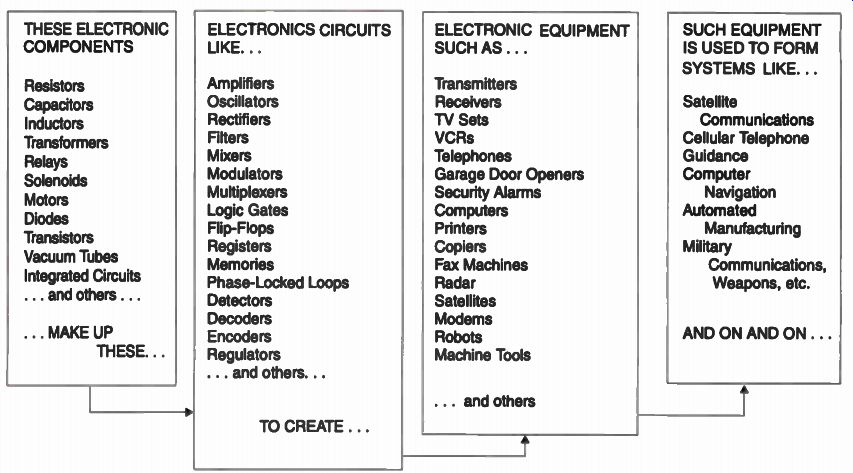
Figure 1. The hierarchy of electronics: Components make up circuits,
which make up equipment used to make systems.
--------------------
What Is Electronics?
Electronics is the study of the behavior of subatomic particles called electrons, and the development and application of circuits and devices that manipulate electronic currents to perform a variety of useful tasks. The general principles of electricity and electronics are derived from physics and are widely known and understood. Electronics, however, is ever-changing, due to the creation of new and better components and circuits which form the electronic instruments and systems with which you are probably familiar. The block diagram in Figure 1 lists some common electronic components and circuits and the types of electronic equipment and systems that are made from them.
-----------------
Overview of the Electronics Industry
The electronics industry can be roughly di vided into four major areas: communications, computers, control, and test and measurement. Almost every type of electronic equipment made, regardless of the application, falls into one of these four major areas. Let's take a look at each in more detail.
Communications
Communications is the largest field of electronics, as well as the oldest It includes all of the equipment and technologies people and machines use for communicating with one an other. The earliest electronic communications system was the telegraph, followed a generation later by the telephone. Today, the telephone system is by far the largest communications network in the world. Communications also includes all radio and television broadcasting.
This is a huge industry with thousands of AM and FM radio and TV stations.
Also included in this category is two-way radio communications. There are so many applications for two-way radio that it is almost impossible to list them all. You are probably familiar with many of them and may even use one of these services yourself. They include aircraft, marine, military, police, fire, taxi, government service, and even personal two-way radios, such as Citizens' Band (CB) and amateur (ham) radio. Cellular telephones also fall into this group.
A special area of communications is data communications, which is essentially the transmission and reception of digital data between computers. Information is transmitted from one computer to another through the telephone system and often by microwave re lay or satellite links. Even personal computers communicate through their local area networks (LANs) and modems attached to re mote information sources, such as bulletin board systems (BBS) and commercial on-line services (CompuServe, Prodigy, GEnie, and America Online). There also are many other special types of communications systems and equipment. These include fiber optics, satellites, cable and interactive TV, radar, navigation systems, and facsimile (fax) machines.
Communications is an enormous field that has an impact on all of us every day. You no doubt use many communications devices every day, particularly the telephone, radio, and television.
Computers The computer industry is a close second in size to the communications industry. Computers and related devices are almost as widely used as communications equipment.
Large mainframe computers have been around since the late 1940s and early 1950s, and, since that time, have greatly evolved in power and capability over the years. There are also the large, fast supercomputers used in scientific research and engineering applications. Smaller, powerful minicomputer systems provide nearly the same computing capacity as the larger mainframes, but at a lower price. Then there are the hundreds of millions of personal computers that are used in offices and homes around the world. Other faster and more powerful desktop computers, basically souped-up personal computers, are engineering and graphics workstations.
Then there are the billions of microcomputers that are built into other pieces of equipment.
While most of these are not programmable general-purpose computers, they are computers in the classic sense of the word. However, they are built into or embedded in other devices, and are therefore dedicated to a single function. Some examples are the microprocessors inside TV sets, automobiles, appliances, and factory machine tools.
The computer field also encompasses peripheral devices. These include color and monochrome video monitors, disk drives, printers, mice, and any other device used for computer input or output operations.
Control
Electronic control equipment is used to automatically manipulate or operate equipment or machinery. One example of control equipment is a device which varies the speed of a motor. Another example is the programmable logic controller (PLC), which is a special type of computer used in industrial applications. PLCs are used to control all kinds of factory machine tools and other equipment. There are also control circuits for dimming lights, switching solenoids and re lays, operating valves, and sequencing the cycles in dish and clothes washing machines.
Control equipment also includes systems used in automated manufacturing plants, such as computer-controlled machine tools, lathes, mills, conveyers, and other robotic devices.
Test and Measurement
The test and measurement segment of the electronics industry is devoted to making precise and accurate measurements of physical and electrical phenomena. The design, development, repair, and maintenance of electronic equipment requires instruments that can accurately measure voltage, current, resistance, frequency, etc. A large part of this field is de voted to general-purpose testers, such as multimeters, oscilloscopes, signal generators, and frequency counters.
Of course, test and measurement capabilities are required in many areas. In manufacturing and process control, instruments are needed to make accurate measurements of physical characteristics, such as tempera ture, liquid level, fluid flow rate, pressure, humidity, and vibration.
Medical electronics is a significant specialized area of the test and measurement field.
It's critical that precise measurements of physiological properties be made so that physicians can make accurate diagnoses.
Other Uses of Electronic Equipment
While most electronic equipment falls into one of the four areas discussed, there are many special areas of electronics that are not so easily classified. Electronic security systems for homes and cars are good examples. There also is the electronic music industry, which encompasses synthesizers, stereo receivers, compact disc (CD) players, digital audio tape (DAT) recorders, and signal conditioning equipment.
As you may have realized, most electronic applications are a mixture of equipment and techniques from two or more of the major areas. For example, an electronic control's out put usually is dependent on some input signal from a test or measurement device.
Also, many personal computers use communications techniques in the form of LANs or modems connected to remote data sources.
Another example is factory control applications. Most of these include a master control computer that operates other equipment that performs the specific control task. These are often also networked, thus adding the communications function. Such mixtures of the various fields are said to be interdisciplinary.
Self-Test Questions.
1 From what field of study do the principles of electronics come?
2 Communications between computers is known as
3 In the field of electronics, what is meant by interdisciplinary?
---------------------
Who Uses Electronic Equipment?
Another way to categorize electronic equipment and systems is by the type of end user.
That is, who is the customer for the equipment, and where is it used? The four major customer categories are consumer, business, industrial, and government/military.
Consumer Electronics
Consumer electronics includes everything that individuals use for personal entertainment or convenience. The telephone is one example.
Your CD player and stereo system, TV set, and electronic keyboard also fall into this category as do home computers, security alarms, garage door openers, and many others. Notice that these consumer electronic products can be sorted by the different categories of communications, computing, and control.
Business
By business, we mean nonprofit as well as profit-making corporations. One example is large insurance companies with massive mainframe computers and hundreds of net worked personal computers. Another example is hospitals, which use administrative computers and related items and medical electronic equipment, such as patient monitoring devices and magnetic resonance imaging (MRI) machines. Almost all businesses use telephones, fax machines, photocopiers, personal computers (and other computers), intercoms, dictating machines, security systems, building environment controls, fire alarms, etc.
Industry
Because business and industry seem similar, industrial uses could logically be lumped under the category of business. But industrial applications are considered separately Because of the different types of equipment used. For example, industries use manufacturing equipment, such as robots, computer controlled lathes and mills, conveyer belts, and other types of manufacturing machines.
Industrial applications also include computers, control equipment, and test and measurement equipment.
Industries use test and measurement equipment in manufacturing and process control applications to produce chemicals, pharmaceuticals, fertilizer, and other kinds of bulk materials. And let's not overlook utilities, such as the telephone companies, electric power companies, and gas and water companies, all of which make extensive use of electronic equipment. These only scratch the surface of industrial applications of electronic equipment.
-----------------
THE ELECTRONICS INDUSTRY - A PROFILE CONSUMER COMMUNICATIONS COMPUTERS CONTROL TEST & MEASUREMENT TVs
Telephones Radios CD Players Home Computers Calculators Security Alarms Blenders Washer/Dryers Auto Ignition & Fuel Thermometers Sphygmomanometer (Blood Pressure Device)
BUSINESS Telephones Fax Machines Satellite Teleconferencing Mainframes Minicomputers Personal Computers (PCs)
Copiers Building Security HVAC Surveying Construction
INDUSTRY Local Area Networks (LANs)
Telemetry Programmable Logic Controllers (PLC) Engineering Workstations Embedded Micros Machine Tools Robots Manufacturing Process Control Quality Assurance
GOV'T & MILITARY Satellites
- Comm.
- Navigation
Navigation Systems Global Two-Way Administrative Database Planning Simulation Weapons
- Missiles
- Tanks
- Artillery Weather Environment Protection
--------------
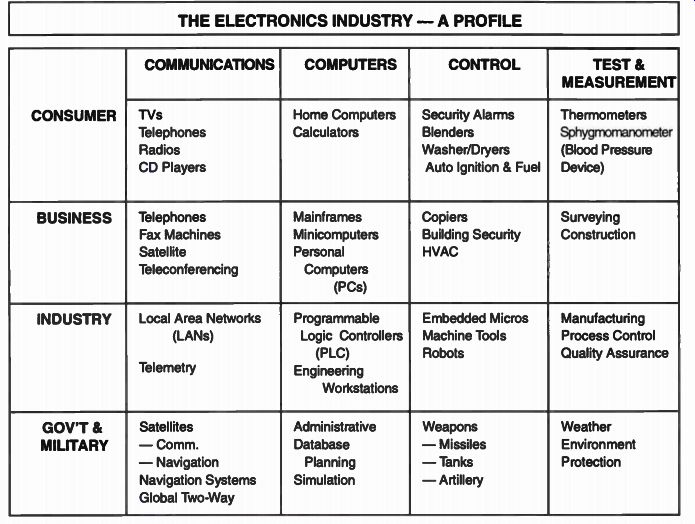
Figure 2. Electronics Industry Profile.
--------------
Government and Military
Since government, including the military, is now the largest employer in our nation and takes in more money than all of the top businesses and industries in the country, it is by far the biggest user of electronics. All government and military offices use telephones, computers, fax machines, copiers, and other types of standard business equipment.
Also, consider operations like NASA, the FAA, the FBI, the CIA, and the military. The military, in particular, has many special electronic weapons and systems for communications, command, and control. Computing is used extensively, as are satellites and many weapon-related special control and communications systems. Radar and navigation equipment are also in wide use.
Figure 2 shows examples of how the various electronic applications are used in the different marketplaces. This table puts into perspective the variety of applications and markets, which tend to mesh and overlap.
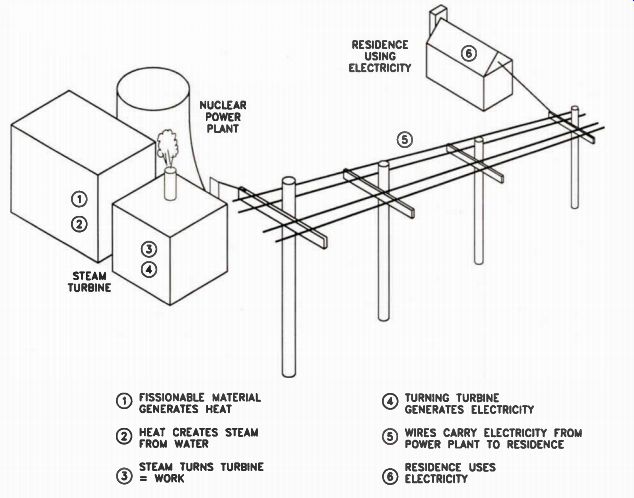
Figure 3. Generating electricity by nuclear fission.
Electrical vs. Electronics Industries
Electronics is the use of electronic components, circuits, and equipment Supgrform teeful functions, such as computing, communications, and control. Related to and associated with electronics is the electrical industry.
This vital industry is primarily concerned with the generation and distribution of electrical power. This includes the electrical generating plants of utilities and their distribution systems and wiring of electricity to our homes, offices, factories, schools, and hospitals.
Figure 3 is a simplified diagram of the generation and distribution of electricity. Energy is produced by burning coal or oil or through nuclear fission. The energy, in turn, produces heat, steam, and pressure, which are used to drive turbines. A turbine convert heat energy into mechanical energy, which is used to drive a generator that produces electrical energy.
The generators produce alternating current.
The alternating current is stepped up to a higher voltage level by transformers and then distributed by power lines. Transformers, in usage areas, step the voltage down before it is wired to homes, offices, and other facilities.
In addition to the generation and distribution of electrical power, the electrical industry also encompasses the distribution and the wiring in homes and buildings; this includes wire, outlets, lighting, switches, circuit breakers, and other equipment found in homes and businesses throughout the country.
Self-Test Questions
4. What is the largest single user of electronic systems?
5. What is the main difference between the electrical and electronic industries?
6. What are the three forms of energy produced when electricity is generated in a nuclear, coal, or oil power plant?
7. What form of energy generate?
8. How are transformers used in the electrical industry?
9. Where does the energy that operates most electronic equipment originate?
--------------------------
The Physics of Electronics
Origin of the Term "Electronics"
The word electronics is derived from the word electron. An electron is a subatomic particle. All matter (things that we can feel, see, hear, smell, and otherwise sense) is made up of tiny particles called atoms. These are combined in an infinite number of ways to produce all physical things.
Atoms are made up of other tiny components: protons, neutrons, and electrons. You will learn more about these subatomic particles in the next topic. For now, just remember that electrons can be freed from atoms.
With an external force or pressure, electrons can be pulled away from the atoms and caused to move. If this external force is great enough, it can cause a large number of electrons to move or, as we say, to flow. This collective movement of electrons in one direction through some material, such as a wire or a component (like a transistor), is known as current flow. When electrons can be made to flow in a concise way, the results can be very useful.
When electron flow is used primarily as an energy or power source, we normally call it electricity. Electricity or electrical power is produced by small batteries or by big generators at your electrical power utility. These power sources cause current to flow, which produces light and heat and which powers all other electrical and electronic equipment in homes and offices.
Electronics is different from electricity in that we precisely control the electron flow to produce a variety of useful effects. For example, varying the amount of electrons moving in a lamp filament allows us to control the lamp brightness, as with a light dimmer. The key to understanding electronics is to realize the many thousands of ways that electron flow can be controlled. You are about to learn how electronic components and circuits are used to control current flow.
Figure 4 is a sketch of a generic electronic application. There is a source of electrical energy, such as a battery or power from a utility company. Its output is called voltage, which is the name of the force that causes the electrons to flow. The electrons make up the current, which flows through a load. A load is a device, such as a light bulb, motor, or antenna, that produces the useful or desired end effect.
Note that the electrons must also flow through a control element. It is this control element that produces the desired effect in the load. It may be a simple resistor, a transistor, a switch, or some complex collection of parts that form a circuit to produce the desired result.
-----------------
VARIES OR MODIFIES CURRENT IN SOME WAY ELECTRICAL POWER SOURCE ( BATTERY, GENERATOR, ETC.) CONTROL ELEMENT (SWITCH, TRANSISTOR, ETC.) - - VOLTAGE PATH OF ELECTRONS PRODUCES ENERGY TO CAUSE CURRENT FLOW LOAD (MOTOR, LAMP ANTENNA, ETC.) PRODUCES SOME USEFUL END RESULT

Figure 4. General model or concept for all electronic circuits and equipment.
---------------------
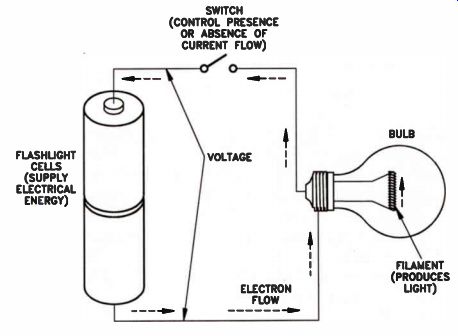
Figure 5. How a basic flashlight operates electronically.
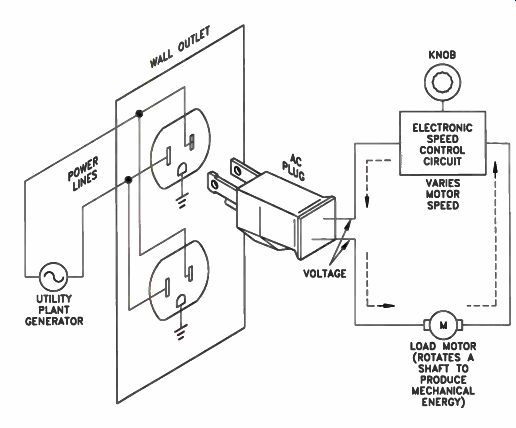
Figure 6. Basic operation of a variable speed electric motor.
Basic Electronic Applications
A flashlight is an example of a basic electronic application. (See Figure 5.) Two flash light cells are connected to form a battery supply voltage. This causes electrons to flow through the light bulb (the load). The control element is the OFF/ON switch. If the switch is open, or acting as an insulator, no current can flow because we have broken the path the electrons would have followed. If the switch is closed, or acting as a conductor, it completes the circuit and allows electrons to flow and the lamp to light.
Another example, a variable speed electric motor, is shown in Figure 6, on the next page.
The electrical power comes from a wall outlet and causes electrons to flow in the load, in this case, a motor. The electron flow produces a magnetic field which, in turn, causes the motor to rotate. The control element is a special electronic circuit that controls motor speed.
Another example, shown in Figure 7, illustrates automatic temperature control. A special heat-sensitive switch, called a thermostat, is connected as the control element between the electrical power outlet and the load - a heating element. Normally, the thermostat is closed, which allows current to flow to activate the heater. As warmer air from the heater reaches the thermostat, the increase in temperature is sensed and will eventually cause the thermostat to open. This will, in turn, cause the heater to turn off, which allows the air around it to cool. When the air gets cool enough, the thermostat will again close, turn on the heater, and restart the cycle of control operation.
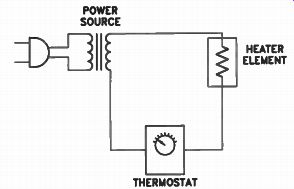
Figure 7. Diagram of a thermostat-controlled heating system.
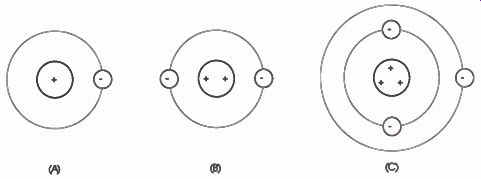
Figure 8. (A) The Hydrogen atom. (B) The Helium atom. (C) The Lithium
atom.
The Atomic Structure of Matter
You don't have to be a physicist or a rocket scientist to know, understand, and enjoy electronics, but it helps if you know a little about the nature of electricity, which forms the basis of electronics. Let's explore some basic principles of atomic structure and current flow to start you on your way.
There are two basic types of electricity, static and dynamic. Both involve charges. A charge is an invisible electrical force somewhat like a magnetic field. Charges are created by the basic atomic structure of materials. So, to begin our discussion of electricity and electronics, let's start with atoms.
As stated earlier, all substances are made up of tiny particles called atoms. Atoms are so small that a piece of copper the size of a grain of sand contains billions of copper atoms.
All of these copper atoms take the same form, and each copper atom can be regarded as an actual piece of copper. There is no smaller unit of copper than one copper atom; this principle is true for all other elements, as well.
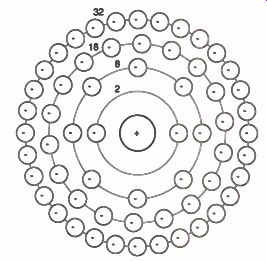
Figure 9. The maximum number of electrons possible in each of the first
four rings of any atom.
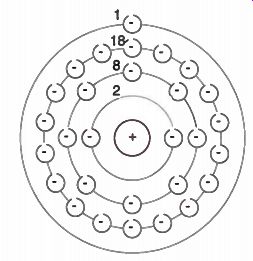
Figure 10. The nucleus of a copper atom has a positive charge of 29.
There are normally 29 electrons around the nucleus.
An atom is not solid. At its center is a nucleus, which has a positive electrical charge.
Traveling around the nucleus in elliptical paths, or rings, are small particles called electrons, which have a negative charge. Every electron has the same mass and the same negative charge.
Most atoms have enough electrons in the rings to balance the positive charge of the nucleus.
The lightest element, hydrogen, has the simplest atomic structure. It has one positive charge in the nucleus and one electron in orbit around the nucleus, as shown in Figure 8(A). Helium, the second element, has two positive charges in the nucleus and two electrons in orbit, as shown in Figure 8(B). Next is a light metal, lithium, with three positive charges in the nucleus and three electrons in orbit, as shown in Figure 8(C). Notice in Figure 8(C) that lithium's third electron travels in a second ring. The first electron ring of an atom can hold two electrons; once the ring is filled, additional electrons must orbit in other rings. The maximum number of electrons in each of the first four rings of any atom is shown on the next page in Figure 9. In general, to find out the maximum number of electrons that each ring can contain, you simply use the 2n2 law, where "n" is the ring number. For example, for the third ring, the maximum number is 2(3)2, or 18.
When the sum of the negative charges on the orbiting electrons exactly balances the positive charge of the nucleus, the atom has no overall electrical charge. When the outer most electron ring contains the maximum number of electrons it can hold, the atom is very stable electrically and chemically. It is very difficult to get an electron to move out of a stable atom or to force another electron into it. On the other hand, if the outer ring lacks one or two electrons, it is very easy to force electrons into position to fill the ring. If an extra electron is forced into an atom, whether the outermost ring is filled or not, the atom will have one more electron than it needs to neutralize the charge of the nucleus.
The atom itself will then acquire a negative charge. In a comparable fashion, if the outer ring has only one electron in it, that electron is not held closely to the atom and can be moved easily out of the ring (into space, or to another atom). This leaves the atom short one electron, and the positive charge of the nucleus is not neutralized. The atom, then, will be positively charged.
The copper atom is an excellent example of an atom with one electron in its outer ring.
The positive charge of the nucleus of the cop per atom is 29. There are 29 electrons in or bit around the nucleus, as shown in Figure 10.
The first three rings of the atom are filled; they have all the electrons they can hold.
However, the twenty-ninth electron required to neutralize the charge of the nucleus is in a fourth ring by itself. This electron is loosely bound to the nucleus. Under the right conditions, it can move easily from one atom to another. This configuration al lows electricity to move easily along a cop per wire, and is one reason why copper conductors are widely used in electronic equipment and electrical power distribution.
The Law of Charges
One characteristic of electrical charges is that like charges repel, and unlike charges attract. This is known as the Law of Charges.
Since like charge's repel, the electrons in an atom all tend to repel one another, and, at the same time, are attracted by the positive charge of the nucleus. A piece of copper contains billions of atoms. Each atom has a nucleus consisting of 29 positive charges, surrounded by 29 negatively charged electrons, which neutralize this positive charge.
The electrons are held by the positive charge on the nucleus which attracts them. At the same time, these electrons repel other electrons in the atom and in nearby atoms. There is a dynamic balance established between the attraction of the nucleus and the circling electrons as they repel other electrons.
If we connect a copper wire to something that pulls electrons from one end and pushes electrons into the other end, an instantaneous chain reaction occurs along the wire. The instant an electron moves out of the fourth ring of one copper atom, its negative charge pushes an electron out of the fourth ring of a nearby atom. This, in turn, pushes an electron out of the fourth ring of another atom.
This happens along the entire length of wire; at the instant an electron moves at one end of the wire, an electron moves at the other end.
You can get a better idea of what's happening if you imagine a hollow tube filled with ping pong balls, as shown in Figure 11(A). Each ping-pong ball is in contact with the next. When you force an additional ball into one end, as shown in Figure 11(B), all the balls in the tube move, and a ball falls out the other end. The movement is nearly instantaneous throughout the length of the tube.
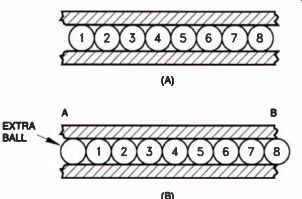
Figure 11. An example with ping-pong balls showing how instantaneous
chain reactions can occur in wires. (A) The ping-pong balls remain stationary
when no force is applied. (B) When an additional ball is added, the original
group of balls shifts to the side, forcing one out of the tube.
Except for the fact that electrons can move much faster than ping-pong balls, the same thing happens when you apply an electromotive force (EME), or voltage, to move an electron at one end (point A) of a wire, as shown in Figure 12. Although the electrons do not touch each other, the force of repulsion between them causes electrons all along the wire to move. If you apply a force great enough to move two electrons, as shown on the next page in Figure 13(A), two electrons would move all along the wire. Similarly, if you increase the force again, three electrons moving at end A, as shown in Figure 13(B), cause a chain reaction of three electrons moving throughout the length of the wire.
The movement of electrons along the wire is called current flow. An electric current is the movement of electrons that have been forced out of atoms.

Figure 12. Instantaneous reaction of electrons in a wire.
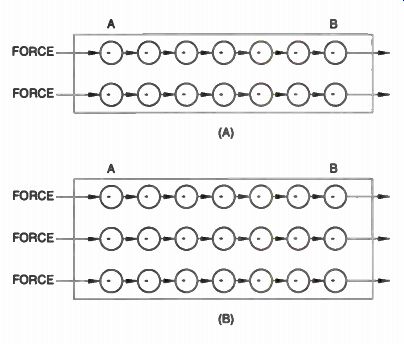
Figure 13. The number of electrons set in motion along a wire depends
on the force applied. (A) Two electrons move along the wire when force
is applied. (B) Increased force causes three electrons to move along Conductors
and Insulators When parts are assembled into an electronic circuit, there
are paths along which the designer wants current to flow, and paths along
which no current should flow. Conductors are used to provide the path
for current flow, and insulators are used to block current where it is
necessary to prevent current from flowing.
Conductors are materials with one or two electrons that can be easily removed from the outer ring. There is no such thing as a perfect conductor, because all conductors offer some resistance or opposition to electric current.
Materials that do not readily give up electrons are used as insulators. Although there is no perfect insulator, materials used as insulators have such a high resistance, and pass so little current, that we can say that these are nonconducting materials. The weak current that is passed through insulating material is called leakage current, and is so low that it is usually considered insignificant. Silver is the best known conductor, but it is used only in special applications because of its high cost. Copper is the next best, and Because it is relatively inexpensive, it is used in most electrical wiring.
Most copper wire used in electronic equipment is covered with a plastic coating. This cover is an insulator, which is used to pre vent a short circuit. If we did not use an insulator over the wire, and two wires accidentally came into contact, a short circuit would occur.
The current would simply flow out one wire and back through the other and perform no useful function.
Self-Test Questions
10. State the Law of Charges.
11. What things are made up of atoms?
12. From which of the three subatomic particles does the word "electronics" come from?
13. Which part of an atom has a positive charge?
14. Which part of an atom has a negative charge?
15. If a copper atom, which normally has 29 electrons and 29 protons, loses one of its electrons, which kind of charge does the atom have?
16. What is the definition of current
17. What is the maximum number' of electrons that can fit into the fifth shell of any atom?
18. Will two protons attract or repel each other?
19. Are materials with three or four electrons in the outer ring good conductors?
Answers to Self-Test Questions
1. The principles of electronics come from physics.
2. Communications between computers is known as data communications.
3. Interdisciplinary refers to a combination of electronic specialties used in a single application.
4. The government is the largest single user of electronic systems.
5. The function of the electrical industry is to generate and distribute electrical power; whereas the function of the electronic industry is the production of electronic components, circuits, and equipment to perform useful functions, such as computing, communications, and control.
6. Heat energy, mechanical energy, and electrical energy are the three forms of energy produced when electricity is generated in a nuclear, coal, or oil power plant.
7. A generator generates electrical energy.
8. Transformers are used to step up the voltage before transmission and to step down the voltage after transmission.
9. The energy that operates most electronic equipment originates at an electrical utility or a power plant.
10. The Law of Charges states that unlike charges attract; like charges repel.
11. All things are made up of atoms.
12. The word "electronics" comes from the word electron.
13. The proton has a positive charge.
14. The electron has a negative charge.
15. The atom has 29 protons and 28 electrons, which yields a net positive charge.
16. Current flow is the movement of electrons along a conductor.
17. 2(5)2, or 50 electrons, is the maximum number of electrons that can fit into the fifth shell of any atom.
18. Two protons will repel each other.
19. No, materials with three or four electrons in the outer ring are not good conductors.
Lesson Questions
This is Lesson Number 4409.
Make sure you print your name, student number, and lesson number in the spaces provided on the Lesson Answer Form. Be sure to fill in the circles beneath your student number and lesson number.
Reminder: A properly completed Lesson Answer Form allows us to evaluate your answers and speed the results and additional study material to you as soon as possible. Do not hold your Lesson Answer Forms to send several at one time. You may run out of study material if you do not send your answers for evaluation promptly.
1. Which discrete component might be used to make up an amplifier?
a. Rectifier.
b. Transistor.
c. Logic Gate.
d. Modulator.
2. The oldest electronic communication system is the:
a. Telephone.
b. Telecom.
c Telegraph.
d. Intercom.
3. Which of the following is a computer peripheral?
a Printer.
b. Transistor.
c. Relay.
d. Transformer.
4. Which of the following would most likely be considered an electronic control device?
a. Lathe.
b Thermostat.
c. Capacitor.
d. Resistor.
5. Which type particle is not part of an atom?
a. Proton.
b. Photon.
c. Electron.
d. Neutron.
6. What is the name of the force which causes electrons to flow?
a. Current.
b. Resistance.
c. Voltage.
d. Inductance.
7. Gold has the simplest atomic structure.
a. True.
b. False.
8. If an atom is neutral and it has two electrons in the first ring and seven electrons in the second, how many protons are in the nucleus?
a. Nine.
b. Two.
c. Seven.
d. Eleven.
9. The Law of Charges states:
a. Like charges attract.
b. Dislike charges repel.
c. Positive charges attract negative charges.
d. Negative charges never attract positive charges.
10. Materials that do not readily give up electrons are used as:
a. Inductors.
b. Insulators.
c. Transmission cable.
d. Conductors.
----------------
HOW TO BUILD CONFIDENCE
Self-confidence - an active faith in your power to accomplish what ever you try to do - is a personal asset that can do big things for you.
Nothing builds confidence like success. Each lesson you successfully complete builds your confidence. The more you accomplish, the more confident you become, and the more you are able to achieve.
Success is habit-forming. Once you get started, you'll find yourself doing something successful every day. Before you know it, your little successes will have built up to that big success you've dreamed of.
Get into the success habit as fast as you can, by resolving to study every day, even if only for a few minutes.
Another confidence builder is a deep, firm faith in yourself - in your ability to get ahead. If you believe in yourself and are willing to back up this faith with hard work, you can safely let the rest take care of itself. With self-confidence grounded in hard work, you can look for ward to success in any field you choose.
Act as if you cannot possibly fail, and you will surely succeed.
---------------------------